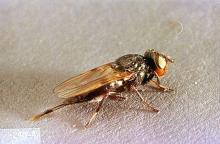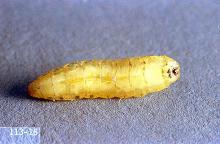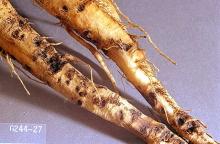Tetanops myopaeformis
Pest description and crop damage Widespread in Idaho and the adjoining Oregon production region, they annually reach economically damaging levels. Spring-emerging adult flies lay eggs in soil next to young sugar beet plants during May and June. Soil-borne larvae subsequently feed on the taproot through mid-July, then diapause as non-feeding, overwintering larvae.
Scouting and thresholds
For larval control
- Use field history to determine the need for at-planting insecticides.
- Determine the timing of postemergence insecticide applications by monitoring local flight activity of adult root maggots with orange-colored sticky traps. Control is most effective when insecticide application coincides with the time of peak seasonal fly capture on traps; earlier and especially later application is less effective. Total seasonal captures of 40 to 50 flies per trap through peak collection justify postemergence treatments. See University of Idaho publication BUL 942, Sugar Beet Root Maggot: Identification, Biology, and Management, https://www.extension.uidaho.edu/publishing/pdf/BUL/BUL942.pdf
For adult control
Adult root maggot flies are highly mobile; they continually colonize fields over long distances during a roughly 6-week egg-laying period. Control requires repeated insecticide applications to kill flies before they lay eggs, but this has the potential negative side effects of selecting for insecticide-resistant strains and triggering outbreaks of aphid and leaf-feeding caterpillars by eliminating their natural enemies.
Management-chemical control
At-plant insecticides (Table 1) may be used where local pressure is consistently high, but post-emergence insecticides (Table 2) applied near peak flight will provide more reliable control. Extensive studies in Idaho have shown that aldicarb provides good control and terbufos does not. Seed treatment can be effective for moderate population levels. Other registered products are less well studied.




